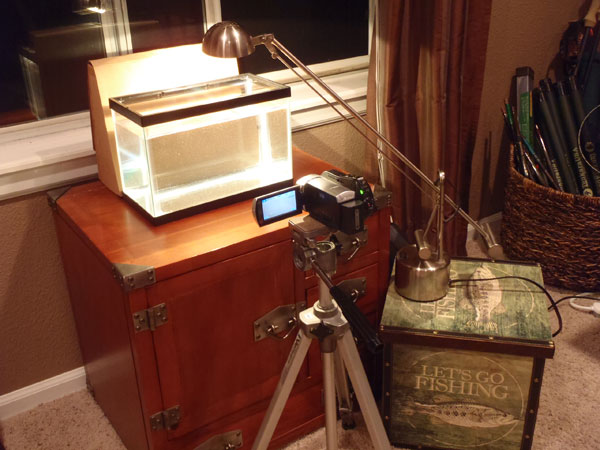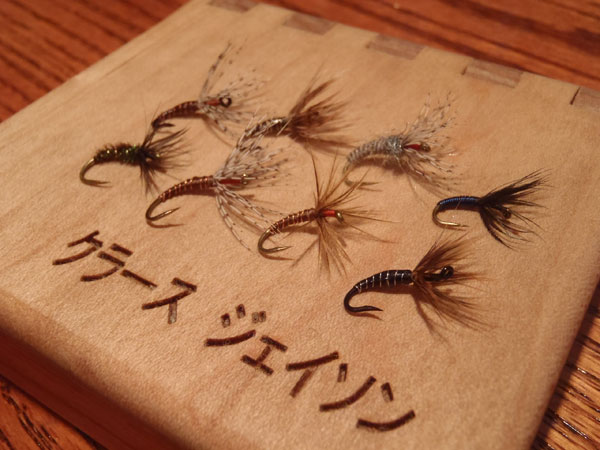I’ve always considered myself a confirmed dry fly fisher but have recently taken an interest in fishing sakasa kebari wet flies. I’ve had a number of experiences lately that are convincing me more and more that they’re not only effective, but just as fun to fish as surface flies (though for different reasons).
The main attractor quality of these flies is the motion of the reversed hackle opening and closing as it’s animated in the water by twitching the rod tip. While I’ve fished them successfully, I’d never closely studied what was going on below the surface to see why the trout might find them so appealing.
So, today, I bought a small aquarium and dragged a few sakasa kebari through the water to get a better understanding of why these flies are so effective.
So what does your sakasa kebari look like underwater?
I tested the three most common hackle types for tenkara wet flies (hen, partridge, and starling), and threw in a wildcard: emu. Before the experiment, I thought the first three would all perform similarly but my money was on the emu for having the most motion. What I found was a bit of a surprise. Watch the video and then I’ll explain below.
While the hen, partridge, and starling hackle all seemed to have the same amount of movement, I was shocked to find that the emu hackle was as stiff as a board–no life whatsoever. The reason this is so surprising to me is that I have always used emu to give movement to flies (eg. gills on hexagenia nymphs).
But video doesn’t lie so I guess my recent post about emu tenkara flies is moot.
Oh well. I like putting the things under the microscope, experimenting, and challenging my own assumptions. At least now I know what some of my tenkara wet flies look like underwater and I know which ones I probably wouldn’t want to tie on. The learning process continues.
Oh, just in case you’re wondering…










Jason, great video. In fact, I’ve been doing exactly the same thing over the last week comparing different hackles, as I can’t find starling to buy in Australia, and I’ve been experimenting as I tie up for the season with different birds. BTW, my experience with emu was similar too.
To help me compare, would you please indicate the size of hook used in all the flies? Was it a size 12 or 14?
Jason, Interesting video. I’d be interested in a followup video of comparing the reverse hackle to western style with the same materials.
Jason, this video is GREAT. What an interesting idea. Question: do you actually work the flies that much when you’re fishing? I am a real beginner and I’m having a lot of trouble understanding how close to a dead drift I should be fishing. In fact I still haven’t caught anything on a kebari or even a killer bug – all my hits have been on traditional Western flies.
Craig,
Thanks for confirm about the EMU. I’m still shocked. As for hook size, all the flies in the video were #12 or #14. In retrospect, I probably should have used all the same size. In the next one, I’ll be more consistent.
Keith,
Are you talking about comparing a reverse hackle to a Western soft hackle?
Alex,
I only work the fly that much if I’m using a wet sakasa kebari. For dries and nymphs, I do a complete dead drift. If you’re using a reverse hackle wet kebari, try slowly pulling back the rod while you gently twitch the rod tip. That seems to do the trick.
I found the same results to you in terms of stiffness of the different cape feathers you tested, the partridge having the most movement. I was surprised that some hen capes feathers really only gave me about the same movement as rooster saddles when tied kebari style, I’d have thought they’d move more or even fold over. Not always the case (sometimes not all).
Also here is list of things I’ve confirmed – they are mostly rather obvious when you stop to think about it:
1. “Less is more” – sparser hackling results in more movement. It allows the barbules to move easier.
2. “Barred is best” – using a barred feather, including grizzle and died grizzle colours. The barring seems to enhance the image of movement and thus life.
3. “Longer is better” – longer hackle length allows more movement of the barbules
4. “Neatness is a virtue” – Neat and even spacing of the barbules around the kebari tie can become important on lightly weighted flies – particularly light grubber/caddis hooks – it you want’ it to move up and down vertically. Otherwise, sloppier ties result in the fly going off to one side as it is pulled up, the side which has more hackle barbules. More weight on the fly helps here, but detracts from the objective, no?
5. “Natural is safer” – On the use of synthetics – difficult to get the required flex for the desired movement, check don’t assume – e.g. krystal flash in black makes great nymph legs, but isn’t flexible enough at this length for movement in a kebari tie collar. The very thin flashabou type material strands work ok, and there are other materials. Again, check first before tying up two dozen.
6. “Herein lies the path to madness” – I’ve stopped for the present to go fishing. My family was starting to look at me strangely due to the time I was spending dabbling test flies like tea bags.
regards
Craig
All good points Craig–this is a great set of advice for anyone wanting to tie tenkara wet flies. I especially agree with your comment about barred feathers. I usually use speckled hen for this reason. It just gives the flies a buggier look.
I wonder what the difference in “vibrations” are. I I saw somewhere on the web where tying the hackle reversed causes different types of vibration that attract fish. http://vodpod.com/watch/4158083-reversed-spider-sea-run-cutthroat-fly?u=caddisflyshop&c=caddisfly
Bob, that’s a good question. I’m not sure how much vibration these flies would actually produce since they’re small and nothing is really hitting anything else to produce a vibration.
A long time ago, someone told me to use big, bulky streamers at night for large brown trout that could sense the water displacement they produce. It worked, but can’t say for sure it was because of water displacement.
In my experience, the fish were coming in to take the flies from a pretty long way off–to far in min mind for them to feel vibration or displacement. It seemed to me they were targeting them visually. But, who really knows except the trout?
Did you ever do something and think to yourself “I bet I’m the only person in the world doing this right now”? Well, we fly tyers probably have that feeling more than most others…nice video though I usually do my fly tests in a large beer glass…
Thanks
p.s. your anti-spam question for me is “what is 4 multiplied by 5” that just seems to be elitist to me, at least I had a calculator handy.
Nice video but who fishes for trout in an aquarium? Moving river water effects hackles in totally different ways.Humans seem to like it but no posts from trout yet.
You should look into Dave Whitlock’s “vibert box” experiments in the 70’s which concerned both shape and motion of flies in running water.
The video was merely to see the difference in the amount of movement between different hackle types. It wasn’t meant to show what they would actually look like in a river.
In a lake, they would look pretty much like this though. In a river, I imagine they’d be even more animated if you’re pulling the fly cross current.